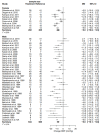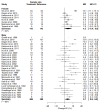Exploring Sex Differences of Beta-Blockers in the Treatment of Hypertension: A Systematic Review and Meta-Analysis
- PMID: 37239165
- PMCID: PMC10216365
- DOI: 10.3390/biomedicines11051494
Exploring Sex Differences of Beta-Blockers in the Treatment of Hypertension: A Systematic Review and Meta-Analysis
Abstract
Aims: In the prevention of cardiovascular morbidity and mortality, early recognition and adequate treatment of hypertension are of leading importance. However, the efficacy of antihypertensives may be depending on sex disparities. Our objective was to evaluate and quantify the sex-diverse effects of beta-blockers (BB) on hypertension and cardiac function. We focussed on comparing hypertensive female versus male individuals.
Methods and results: A systematic search was performed for studies on BBs from inception to May 2020. A total of 66 studies were included that contained baseline and follow up measurements on blood pressure (BP), heart rate (HR), and cardiac function. Data also had to be stratified for sex. Mean differences were calculated using a random-effects model. In females as compared to males, BB treatment decreased systolic BP 11.1 mmHg (95% CI, -14.5; -7.8) vs. 11.1 mmHg (95% CI, -14.0; -8.2), diastolic BP 8.0 mmHg (95% CI, -10.6; -5.3) vs. 8.0 mmHg (95% CI, -10.1; -6.0), and HR 10.8 beats per minute (bpm) (95% CI, -17.4; -4.2) vs. 9.8 bpm (95% CI, -11.1; -8.4)), respectively, in both sexes' absolute and relative changes comparably. Left ventricular ejection fraction increased only in males (3.7% (95% CI, 0.6; 6.9)). Changes in left ventricular mass and cardiac output (CO) were only reported in males and changed -20.6 g (95% CI, -56.3; 15.1) and -0.1 L (95% CI, -0.5; 0.2), respectively.
Conclusions: BBs comparably lowered BP and HR in both sexes. The lack of change in CO in males suggests that the reduction in BP is primarily due to a decrease in vascular resistance. Furthermore, females were underrepresented compared to males. We recommend that future research should include more females and sex-stratified data when researching the treatment effects of antihypertensives.
Keywords: beta-blockers; hypertension; meta-analysis; sex differences; systematic review.
Conflict of interest statement
The authors declare no conflict of interest. Furthermore, there are no known conflicts of interest associated with this publication, and there has been no significant financial support for this work that could have influenced its outcome. We confirm that the manuscript has been read and approved by all named authors and that there are no other persons who satisfied the criteria for authorship but are not listed. We further confirm that all have approved the order of authors listed in the manuscript.
Figures








References
-
- World Health Organization Cardiovascular Diseases (CVDs) [(accessed on 8 July 2022)]. Available online: https://www.who.int/news-room/fact-sheets/detail/cardiovascular-diseases...
-
- Mosca L., Linfante A.H., Benjamin E.J., Berra K., Hayes S.N., Walsh B.W., Fabunmi R.P., Kwan J., Mills T., Simpson S.L. National study of physician awareness and adherence to cardiovascular disease prevention guidelines. Circulation. 2005;111:499–510. doi: 10.1161/01.CIR.0000154568.43333.82. - DOI - PubMed
Publication types
LinkOut - more resources
Full Text Sources

